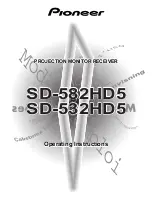
Glossary
221
This section briefly explains the difficult terms that are not explained in the
text of this guide. For details, refer to other commercially available
publications.
AMX Device
Discovery
AMX Device Discovery is a technology developed by AMX to
facilitate AMX control systems for easy operation of the target
equipment.
Epson have implemented this protocol technology, and have
provided a setting to enable the protocol function (ON).
See the AMX Web site for more details.
URL
Aspect Ratio
The ratio between an image's length and its height.
Screens with a horizontal:vertical ratio of 16:9, such as HDTV
screens, are known as wide screens.
SDTV and general computer displays have an aspect ratio of
4:3.
Component Video A method that separates the video signal into a luminance
component (Y), and a blue minus luminance (Cb or Pb) and a
red minus luminance (Cr or Pr).
Contrast
The relative brightness of the light and dark areas of an image
can be increased or decreased to make text and graphics stand
out more clearly, or to make them appear softer. Adjusting this
particular property of an image is called contrast adjustment.
DHCP
An abbreviation of Dynamic Host Configuration Protocol, this
protocol automatically assigns an IP address to equipment
connected to a network.
DICOM
An acronym for Digital Imaging and Communications in
Medicine.
An international standard that defines image standards and a
communications protocol for medical images.
Gateway Address This is a server (router) for communicating across a network
(subnet) divided according to subnet mask.
HDCP
HDCP is an abbreviation for High-bandwidth Digital Content
Protection.
It is used to prevent illegal copying and protect copyrights by
encrypting digital signals sent over DVI and HDMI ports.
Because the HDMI port on this projector supports HDCP, it
can project digital images protected by HDCP technology.
However, the projector may not be able to project images
protected with updated or revised versions of HDCP
encryption.
HDMI
™
An abbreviation for High Definition Multimedia Interface.
HDMI
™
is a standard aimed at digital consumer electronics and
computers. This is the standard by which HD images and
multichannel audio signals are digitally transmitted.
By not compressing the digital signal, the image can be
transferred at the highest quality possible. It also provides an
encryption function for the digital signal.
HDTV
An abbreviation for High-Definition Television that refers to
high-definition systems which satisfy the following conditions:
• Vertical resolution of 720p or 1080i or greater (p =
Progressive, i = Interlace)
• Screen aspect ratio of 16:9
Infrastructure
mode
A method for wireless LAN connection in which devices
communicate through access points.
Interlace
Transmits information needed to create one screen by sending
every other line, starting from the top of the image and working
down to the bottom.
Images are more likely to flicker because one frame is displayed
every other line.
IP Address
A number to identify a computer connected to a network.
Progressive
Projects information to create one screen at a time, displaying
the image for one frame.
Even though the number of scan lines is the same, the amount
of flicker in images decreases because the volume of
information has doubled compared with an interlace system.
Summary of Contents for EB-L400U
Page 1: ...User s Guide ...





































